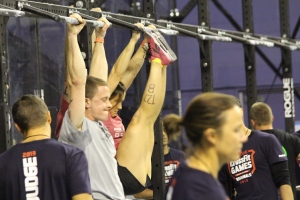5 Tips on How To Improve Your Toes-To-Bar
 Toes-To-Bar (TTB) is a movement that is designed to test your abdominal and arm strength as well as your grip strength. "Big Rigs" like me don't fare so well with TTB - the small gymnastics-background girls go much better at this movement.
Toes-To-Bar (TTB) is a movement that is designed to test your abdominal and arm strength as well as your grip strength. "Big Rigs" like me don't fare so well with TTB - the small gymnastics-background girls go much better at this movement.
The movement is simple enough. Start in the hanging position on the bar with the heels starting behind the vertical plane of the bar. You then get both toes to touch the bar at the same time and finish by having both feet pass under the bar again.
Here is how slow, strict Toes to Bar looks like...
 1. Hip Flexibility Is Important
1. Hip Flexibility Is Important
If your hips struggle to flex, you will have to find the flexion from somewhere and that is usually from the back
Some key exercises you may want to try are
- Romanian Deadlifts
- Good Mornings
- Single and Double-Legged Hamstring Stretches
Always have your back straight and try to feel it stretch in the back of the leg
2. Grip Strength Is Often Compromised
If the workout also has barbell work in it, the Toes-To-Bar will affect your grip strength and ability to hold onto the barbell.
You will have enough time before the Open starts to get some grip strength training in. Try Farmers Carries, Hanging from the Bar for time, Grip strengthening exercises with the different tools out there.
3. A Tighter Kip Will Help Advanced Athletes
The best athletes at Toes-To-Bar have a short, sharp kip. The longer your kip, the more time it takes to complete the reps. Also, if you have a long kip, you can lose rhythm and start to swing too much during your TTB...something I am guilty of doing!
4. Practice Your Rhythm
So the secret to getting TTB going nicely is to think about having your hips forward of the bar as your heels come behind the line of the bar...and then doing that fast enough to take advantage of the fact you are now loaded up into the kip for the next rep.
I am personally too slow - I get my hips in position but my feet take too long to get down and by the time I am ready for the next rep, my hips are now behind the line of the bar and I have to swing, kip and do the next one...so terribly inefficient!
In the video below, Chris Spealler talks about getting the feet down to the ground fast...I agree to a point. What I think is more important (and what you see on the video) is that getting your hips down in front of the bar and heels behind the bar is what loads you up for the next rep...just keep practicing it!
.
 5. Learn To Deal With Minimal Chalk
5. Learn To Deal With Minimal Chalk
This could be a whole blog post on its own!
Most bars have plenty of chalk on them. Your hands are dusted with chalk at the start. Chalking your hands takes time. Taking time means more reps are lost in the Open!!
We have some pretty amazing girls at our gym. Kat and Ev Dalecki are in this blog post and often feature in my videos because they have such beautiful technique. They are CF Gymnastics coaches and CrossFit coaches at Reebok CrossFit GCS. You don't see them spending hours at the chalk bucket. They get what they need before the WOD and during the transitions if required and get on with it.
For my patients, I often have them demonstrate movements for me...and then I find out what type of "Chalker" they are...
- The Nervous Chalker - Out of habit, they chalk up, often multiple times. They are often unaware of their behaviour because they are thinking about what they are about to do...
- The Chalk Whore - Thinks that more chalk makes things better (it doesn't). Often leaves a chalk cloud behind them in and around the bucket. Often will bring a bucket to be close to themselves.
- The Realist (me!) - Realises that there are plenty of chalk whores in every gym so all the bars and barbells have enough chalk on them already. I am unlikely to get more than 10 TTB out in one go so I don't need to chalk up - If I was going for 30 unbroken, I would consider it...I chalk just a tiny amount - enough to give me grip, not enough that my sweat turns it into a paste on my hands!
Practice with minimal chalk - you never know when you will need these skills. I am sure if you had to scramble across a fallen mountainside, you would be fine without chalk...
__________________________
6 Tips Common to All Movements
Basically similar to my blog on preparing for the Open...
1. Practice your technique NOW
- Feel comfortable in practice with competition technique and Range of Motion (ROM) and it will feel comfortable in competition.
- Good technique is the most efficient way to complete the reps. For most movements, keep your back straight for crying out aloud!!
- Motor patterns are strengthened with perfect practice - the more reps you do perfectly, the more likely you will do them
2. Continue your strengthening program (or start NOW!)
- There are still 5 weeks before the Open starts and 9 weeks until it ends - there is time to make gains!
- If you just get one more rep out because you are just a little bit stronger or you get a PB because you improved enough to achieve it, there is no better feeling in the Open. Last year, I got a 135lbs snatch 4 times - I got my first the day before I did 13.1. I also got my first CTB pullup during the Open. Strength helps!
- If you are a Regionals athlete, the Open should just be a speed bump in your training program.
- I have never heard anyone say "If I was only a bit weaker for that workout, I would have done better"!
3. Get your Coach to help identify and rectify your weaknesses
- Most coaches are happy to tell you what to work on and will give you accessory (additional) exercises to do after your workouts.
- Most coaches will have some form of one-on-one coaching sessions they can do with you - these are worth it for beginners and experienced athletes alike
- If you do ask your coach for help and you DO NOT do what they say, then please DO NOT ask them for more help until you have done what they told you to do already!! Nothing is more frustrating to a coach than someone who asks for help but then doesn't do it.
- If you have done everything you are told to do and your coach doesn't want to help you, ask yourself if you are in the right box or asking the right person...this should be extremely rare...in general and basically every box I have been to (over 20) and coaches I know (well over 50) have had coaches that are willing to help the athletes and care about their safety.
4. Sort your niggles out
- One of the most common comments I hear is "If I had known how much better I would feel, I would have come sooner"
- 'Nuff said!
5. Don't push to failure
- Rich Froning rarely fails a rep. Don't waste your energy on failed reps. Rest and just concentrate on making good reps. Pushing to failure is a waste of time and energy and significantly increases your risk of injury...
6. Lose the "sins of Christmas" - get that body fat% down!
- This one is for my friend John Z - all the bodyweight movements in the Open will get better if you are carrying less fat.

Pingback : 5 Tips on Preparing for the 2014 CrossFit Open | The Physio Detective
Pingback : Spartan Performance » CROSSFIT SUFFOLK: Powered By SPARTAN PERFORMANCE
Pingback : CrossFit Open 14.4 – Tips and Suggestions | The Physio Detective
Pingback : CrossFit Harmony – W.O.D. 6.11.2014
This is good and will definitely help. I have really long legs and struggle to kip efficiently on the bar. I do the slow kip and fall out of rhythm easily because I am too slow to get my feet back down too. I’m going to try to practice the fast kip and send my feet straight down!!!!
Going to try to increase my grip strength too!
Thanks for the tips 🙂
Wish me luck!
Good luck! Let us know how you go 🙂
Pingback : Monday 7.28.14 | CrossFit Palm Beach
Pingback : Wed, 6 Aug 2014 | CrossFit Bolling
Pingback : Week 20- Update: Time to take stock « multiple sclerosis and crossfit
Pingback : CrossFit Open 15.1 and 15.1a Thoughts and Advice | The Physio Detective
Pingback : Tuesday 8/9/16 | MVMNT | Marietta, Georgia
Pingback : toe to bar | hold the olives
Pingback : Tuesday, Feb. 7 CrossFit Workout of the Day - EVF360
Pingback : Why my week was #BETTER | CLE Sports PT & Performance